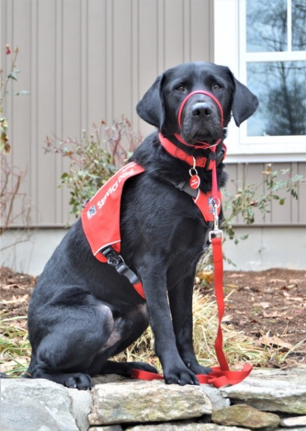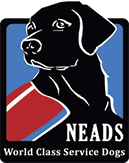Guidelines for Assistance Dogs
CDC Guidance for Handlers of Service and Therapy Animals
The CDC has created guidelines for ways to protect therapy animals. Many of the NEADS guidelines and beliefs line up with the CDC guidelines.
- Please be sure that anyone who is petting your dog (with your permission) wash their hands before and after. If using a hand sanitizer, it should have 60% alcohol content.
- Do your best to not let your clients go face to face with the dog.
- Try to minimize the dog licking as best as you can.
- You, as well as any of your clients who are interacting with the dog while at work should be wearing a mask.
- Do not put a mask or face covering on the dog.
- Do not wipe or bathe the dog with any sort of disinfectant. There is no evidence that the virus can spread to people from the skin, fur, or hair of dogs.
- Disinfect or wash items that may be used by multiple people – brushes, toys, leashes, capes, blankets.
- The dog should not be around people with symptoms of COVID-19.
Source: CDC Website
NEADS Tips for Accommodating Guidelines
- Carry small bottles of hand sanitizer with you if you are moving out and about at work. You can have a permanent bottle stationed at the door of your office for all to sanitize on the way in and out prior to interacting with your dog. You could also carry appropriate sanitizing wipes for hands to be used if a sink or sanitizer is not available.
- If petting is necessary and there are concerns even with handwashing/sanitizing hands, the clients can wear disposable gloves to be thrown away after interacting with the dog. Multiple pairs of lightweight washable gloves could be purchased and after a single use, be put in a Ziploc bag and washed in the washing machine at the end of the day.
- It’s impossible to fully stop a dog from licking as it is a normal behavior, but you can manage the dog and clients in different ways to try to reduce the frequency it happens. For example, as mentioned above, not letting your clients put their face near the dog’s face. Aiming for calm petting and approaches may reduce excitement from your dog and reduce the possibility of licking. Having the dog in a sit, stay or down, stay with the client sitting or standing next to their side rather than in front of the dog may also help.
- Use toys that can be washed and dried easily – tennis balls, fleece tug ropes (can be made with material), plush toys, etc. Hard rubber toys – like chuck it balls, KONG balls, KONG frisbees, etc. – can also be disinfected in hot, soapy water. Having access to multiples will allow one to be used with one client, then put aside to be washed, and a clean one to be pulled out for a new client.
- If traveling to multiple locations, having a blanket or mat at each location to limit transferring objects from location to location. An easily disinfected mat, like a yoga mat, could also be used if having more than one mat is not a good option.
- Purchase extra capes, gentle leaders, collars, and leashes to allow for each set to be washed at the end of the day in cold, soapy water. Then use a new clean set the next day at work.
- If not washed daily, capes, gentle leaders, collars, and leashes can also be disinfected using Lysol spray or Rescue, which is a solution that can be diluted and sprayed on the equipment. Always remember to take the equipment off the dog before spraying it. if you’d like more information about Rescue, please reach out to NEADS.
- Even though there is no evidence that COVID can transfer from a dog’s fur to a person, you can use baby wipes or dog bath wipes after someone has pet them if it makes others or supervisors more comfortable. These do not have disinfecting components and any wipe with those should not be used on dogs.
- If you have any of your clients hold the 4-foot red, Velcro leash provided to you in training, we recommend switching this leash to a 6-foot leash to provide the option for the 6-foot social distancing guideline. Making knots at shorter lengths in the leash as a focal point on where a client can hold would be okay if a certain circumstance allows for safely being closer.
NEADS Guidance for Adjusted Work Schedules
These are NEADS preferences for how much an Assistance Dog is on site and working in order to maintain its training. We understand that for many of you, especially those who work in the school system, it’s unknown what your schedule will be and if/when it will change. NEADS is always here to help you work through your individual circumstances. Please reach out for guidance if you are unsure how to proceed with your new schedule.
- If you are on-site at your job with your pre-COVID regular schedule, we would like the dog there a minimum of 3 days a week or 75% of the time.
- If you are working a split schedule (50% work on site and 50% from home), we would like the dog with you for the 50% work on site.
- If your schedule has completely shifted to work at home or your employer asks you to not bring your dog into work, please contact your NEADS trainer for guidance on care that your dog may need if home for extended periods of the day.
- If your employer asks you to not bring your dog to work, an alternative option that NEADS would like to explore would be if the dog could still come to work with you and remain with you in your office (or in a crate when you aren’t), but not interact with the clients they typically do.
Creative Ways to Work with Your Assistance Dog
Unfortunately, COVID-19 has forced us all to be creative about different ways to accomplish things in our lives. Using your Assistance Dogs is another one of those things. You may have already achieved this, but here are some suggestions to start with:
- Ask your employer if they are willing to create an email address for the dog. This will allow your clients a way to send a special message to the dog without being there in person. You can email back as your dog and how you think they should respond if they could talk.
- Use one of the many video chat options available now – Zoom, Google Meets, Microsoft Teams, FaceTime – as a way to hold individual sessions or group sessions remotely. You can ask your dog to “jump” on a higher surface like a bench, chair, or bed so they are higher and can be seen next to you while in the session. This can be done on-site, but also from home.
- Take pictures of your Assistance Dog doing different things – in a serious pose, silly pose, in a tranquil environment, etc. If meeting virtually, you can email these ahead of time or share your screen with these pictures. Since the dog can’t be there in person, you can use the picture as a focal point and base the picture you show on what you are looking for in the session.
- Think of the tasks that give your clients the most help and joy, and give some thought to whether you doing those in person from a distance, or virtually, could still provide some level of that help or joy even though the dog isn’t right next to them.
- Create a mailbox for the dog outside your office – clients can write a note or draw a picture to be left in the mailbox. You can write a note back to the client from the dog as a way to acknowledge they received it and what they thought about it. You could also put the picture up on the wall, take a picture of the dog next to it, and print it out to give to the client with a little note from the dog.
- Look into getting a “paw print” stamp – either a generic one or see if websites like Etsy can make a custom made one with your dog’s actual paw print. This could be a fun way to “sign” any correspondence back from the dog.
- Hang a whiteboard on your office door and have a “dog of the day” message to inspire clients, make them laugh, etc. You could also have your clients help you come up with these as a remote way of being involved with the dog. A similar message could be done at the bottom of your emails or on daily school announcements in the morning.

